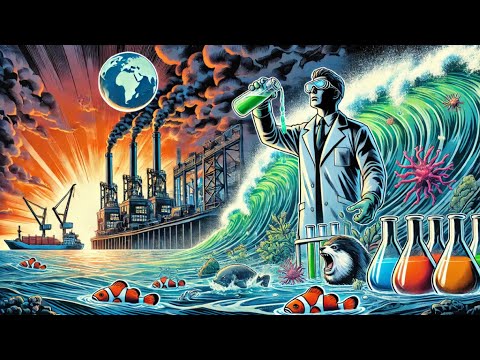
Can we hack the oceans to fight global warming? 🌎 Scientists are experimenting with ocean-based carbon removal, but is it a miracle fix or a looming disaster? 😨
This UPSC Podcast explores the burgeoning field of ocean-based carbon dioxide removal, focusing on the efforts of companies like Planetary Technologies that are experimenting with methods such as introducing minerals into seawater to enhance its natural ability to absorb atmospheric carbon. The talk outlines the scientific rationale behind these approaches, the various techniques being explored by different entities (including sinking organic matter and growing marine organisms), and the significant financial investment driving this emerging industry. However, it also critically examines the debates and concerns surrounding the potential environmental consequences and the effectiveness of these methods at a large scale, highlighting the tension between the urgency to address climate change and the need for careful scientific evaluation and community engagement.
🔬 What You’ll Learn:
✅ How do ocean hacks work? 🌊
✅ Could this save the planet? 🌱
✅ The hidden risks & dangers 🚨
✅ Is this science or playing God? 😱
👉 This could change the future of climate action—Watch now!
🔗 #ClimateChange #OceanHack #GlobalWarming #CarbonRemoval #SaveThePlanet #GreenEnergy #EnvironmentalScience #scienceexplained #ClimateHacking #OceanScience #CarbonCapture #GlobalWarming #ClimateCrisis #SaveOurOceans #Geoengineering #ScienceExperiment #GreenEnergy #EnvironmentalRisk #MarineEcosystem #CoralReefs #OceanPollution #SustainableSolutions #CarbonRemoval #OceanPreservation #ClimateSolutions #SeaLevelRise #ClimateInnovation #FutureScience #elonmusk
#upsc2025 #YouthEmpowerment #UPSCPodcast #FutureReady 🚀📈🎙️ #GovernmentPolicy #UPSCMains #GS1 #GS2 #GS3 #GS4 #UPSCPreparation #DailyDiscussion #CivilServicesExam #CurrentAffairs #upscstrategy🚀
#UPSCPreparation #IASPreparation #UPSCExam2025 #UPSCMotivation #CSEPreparation #UPSCInEnglish #IASCoaching
#UPSCinKarnataka #IASPreparationKarnataka #BangaloreUPSC #HyderabadUPSC #UPSCinTelangana #IASPreparationTelangana
#UPSCinTamilNadu #TamilNaduIASAcademy #ChennaiUPSCPreparation #UPSCinKerala #KeralaIASAcademy #UPSCMalayalam
#SouthIndiaUPSC #UPSCforSouthIndians #IASinSouthIndia #UPSCForBeginners
#UPSCFoundationCourse
#UPSCPreparationFromCollege
#IASPreparationForStudents
#UPSCJourneyBegins
#UPSCFromFirstYear #UPSCStudyPlanForStudents
#UPSCWithoutCoaching
#SelfStudyForUPSC
#HowToStartUPSCPreparation #CollegeToIAS
#UPSCStudyTips
#UPSCPreparationInCollege
#UPSCPrelimsStrategy
#IASFoundationBatch
🔥 Stay updated
source




Frequently Asked Questions About Ocean-Based Carbon Dioxide Removal
1. What is ocean-based carbon dioxide removal (CDR) and why is it being explored?
Ocean-based CDR refers to a variety of proposed techniques that aim to enhance the ocean's natural ability to absorb and store carbon dioxide (CO2) from the atmosphere. These methods are being explored because most climate models suggest that reducing greenhouse gas emissions alone will not be sufficient to meet global climate goals. Active removal of CO2 is considered necessary to mitigate the effects of climate change. The ocean, with its vast surface area and existing role in the carbon cycle, is seen as a potential large-scale reservoir for captured carbon.
2. What are some of the primary methods being tested or proposed for ocean-based CDR?
Several approaches are being investigated. One prominent method involves enhancing ocean alkalinity by adding minerals like magnesium oxide, olivine, or limestone. These alkaline substances react with dissolved CO2 in seawater, converting it into stable bicarbonate ions, effectively allowing the ocean to absorb more CO2 from the atmosphere. Another strategy focuses on increasing the growth of marine organisms like seaweed, algae, and phytoplankton, which absorb CO2 during photosynthesis. Once these organisms die and sink to the deep ocean, the carbon they contain can be sequestered for long periods. A third approach involves directly sinking organic materials like wood chips, crop waste, or seaweed to the deep seafloor, preventing their decomposition and the release of CO2 back into the atmosphere.
3. What is the role of Planetary Technologies in the ocean-based CDR field?
Planetary Technologies, based in Nova Scotia, Canada, is one of the companies actively pursuing ocean-based CDR. Their primary method involves pumping a slurry of magnesium oxide into the ocean. They hypothesize that this will increase the ocean's alkalinity, enabling it to absorb more atmospheric CO2 and convert it into stable molecules. Planetary is also selling carbon credits based on the amount of CO2 they claim to be removing. They are participating in the XPRIZE Carbon Removal competition funded by Elon Musk's foundation.
4. What are the potential benefits of ocean-based CDR technologies for the climate and the ocean?
Proponents of ocean-based CDR argue that these technologies could play a crucial role in removing significant amounts of CO2 from the atmosphere, thereby helping to mitigate global warming and its associated impacts. Some methods, like increasing ocean alkalinity, could also potentially help to counteract ocean acidification, a threat to marine ecosystems caused by the absorption of excess CO2. Additionally, some projects, like Vesta's use of olivine, suggest potential co-benefits such as coastal protection against storm surges.
5. What are the main concerns and criticisms surrounding ocean-based CDR?
Despite the potential benefits, significant concerns exist regarding the environmental consequences and efficacy of ocean-based CDR. Critics worry about the potential impacts of adding large quantities of minerals or organic matter to marine ecosystems, including smothering seafloor habitats, disrupting food webs, and harming sensitive species like sea turtles and fish eggs. There are also questions about the long-term fate of the captured carbon and whether it will remain sequestered or eventually be released back into the atmosphere. Furthermore, the lack of comprehensive long-term studies and the rapid pace of some projects, coupled with insufficient regulatory oversight, have raised concerns about unintended and potentially irreversible consequences.
6. How are these ocean-based CDR projects being funded and incentivized?
Many of these early-stage ocean CDR companies are financing their research and operations by selling carbon credits. These credits represent a specific amount of CO2 removed from the atmosphere or ocean and are purchased by companies looking to offset their emissions. However, the market for marine carbon credits is largely unregulated and faces debates about the accuracy and permanence of the claimed carbon removal. Philanthropic funding, such as the $1 million from the Musk Foundation for Planetary Technologies, also plays a role.
7. What are the challenges in monitoring, verifying, and scaling up ocean-based CDR technologies?
Monitoring and verifying the actual amount of CO2 removed and the long-term fate of the captured carbon in the vast and dynamic ocean environment is a significant challenge. Tracking the dispersal and impacts of added materials is also complex. Scaling up these technologies to a level that would have a meaningful impact on global climate change would require enormous resources, energy, and infrastructure. For example, the widespread use of seaweed farming would necessitate vast coastal areas. Concerns also exist about the potential for unintended large-scale environmental consequences if these technologies are deployed at a global level.
8. What are the social and regulatory challenges facing ocean-based CDR development?
Gaining public and community support for ocean-based CDR projects has proven challenging. Coastal communities, particularly fishing industries, often express concerns about potential negative impacts on marine life and their livelihoods. Obtaining necessary permits and navigating regulatory frameworks is also complex, as these technologies are relatively new and lack established guidelines. Building trust and ensuring transparency in research and deployment are crucial for addressing public skepticism and securing the social license needed for these technologies to advance responsibly.